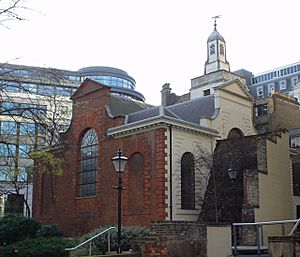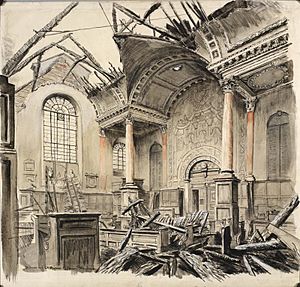St Anne and St Agnes facts for kids
Quick facts for kids St Anne & St Agnes Church |
|
|---|---|

Exterior of St Anne & St Agnes Church
|
|
| Location | London, EC2 |
| Country | United Kingdom |
| Denomination | Anglican, Lutheran, originally Roman Catholic |
| Architecture | |
| Heritage designation | Grade I listed building |
| Architect(s) | Sir Christopher Wren |
| Style | Baroque |
| Years built | rebuilt 1680 |
St Anne and St Agnes is a historic church in the City of London. You can find it on Gresham Street, close to the Barbican. This church is part of the Anglican faith. For many years, from 1966 to 2013, it was used by a group from the Lutheran Church in Great Britain.
| Top - 0-9 A B C D E F G H I J K L M N O P Q R S T U V W X Y Z |
The Church's Long History
The first time a church was mentioned on this spot was in 1137. Old papers talked about 'St Agnes near Alderychgate' and a 'priest of St Anne's'. There was some confusion about the name. In records from the Norman times, it was called 'St Anne-in-the-Willows' or just St Agnes.
It's special because it has a double name, which is rare for churches in London. This double name, St Anne and St Agnes, likely came about in the 1400s.
Fires and Rebuilding
The church was badly damaged by a fire in 1548. But it was rebuilt not long after. More work was done on the building in 1624.
However, the famous Great Fire of London in 1666 caused huge damage. Only the church's 14th-century tower survived, and even that was only partly left.
Rebuilt by Christopher Wren
St Anne and St Agnes was rebuilt in 1680 by the famous architect Sir Christopher Wren. He might have had help from Robert Hooke. This small brick church has a unique design for London. It's shaped like a Greek cross.
Wren used a special design where a vaulted square is inside another square. This idea came from the Nieuwe Kerk in Haarlem, Netherlands. Wren also used a similar design for St Martin Ludgate and St Mary-at-Hill.
After the Great Fire, the nearby church of St John Zachary was not rebuilt. So, in 1670, its parish joined with St Anne and St Agnes.
Modern History and New Purpose
The church was repaired many times in the 1700s and 1800s. But it was mostly destroyed again during World War II. German bombers attacked London during the London Blitz on December 29-30, 1940.
The church was rebuilt and opened again in 1966. Many donations came from Lutheran churches around the world. It was used by Estonian and Latvian communities living in London. The inside of the church now has a mix of new parts that look like the old ones. It also has original pieces from other London churches that were destroyed in the war.
In June 2013, the Lutheran group moved out. They now share St Mary-at-Hill with its Anglican church members. St Anne and St Agnes is now called the VOCES8 Centre. It is home to the VOCES8 Foundation, which is a charity that helps with music education. It includes the vocal group Voces8.
Famous Visitors
Many famous people have been connected to this church. The poet John Milton was a parishioner, meaning he lived in the church's area. So was John Bunyan, who wrote the famous book Pilgrim's Progress.
John Wesley, who started the Methodism movement, preached at the church twice in 1738. The church was officially named a Grade I listed building on January 4, 1950. This means it's a very important historic building.
See Also


